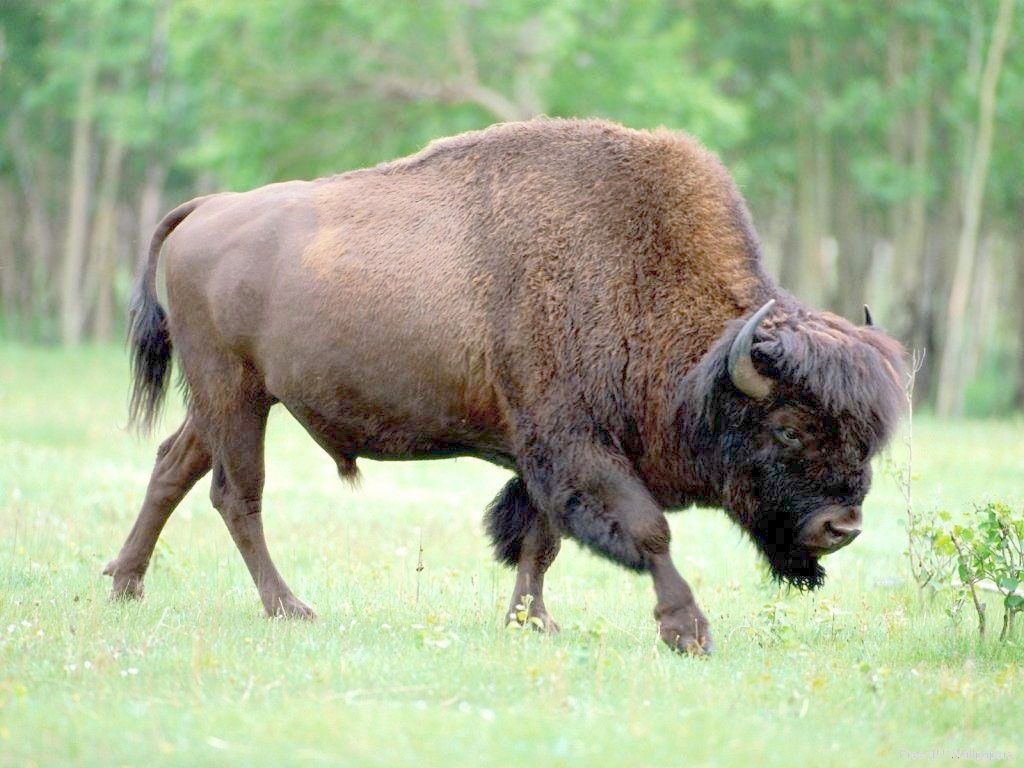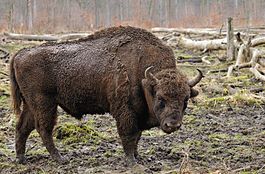Wood bison habitat
The wood bison, a unique large mammal, is an endangered species and is under special protection; it is listed in the Red Book of the International Union for Conservation of Nature (IUCN). The protection of the wood bison is provided for by the International Convention on Biological Diversity, signed, along with other countries, by the Russian Federation. Currently, it lives only in Canada.
American bison belong to the bovid family, a genus of bison. It is believed that they once came to the American continent from Asia, penetrating through Chukotka to Alaska.
They have a more massive front part of the body, a relatively long thick mane, and short blunt horns.
There are two subspecies of bison in North America - steppe and forest. Steppe species are distributed mainly in the USA, forest species – in Canada. Due to their small numbers, they live only in national parks. Wood bison are larger than their counterparts, they have darker, thicker and silkier hair, longer and thinner horns, and a shorter mane.
When the conquistador Coronado landed in America and penetrated the Grand Prairie in 1541, the bison were so numerous that “they could not be counted.” About 60 million mighty giants grazed on the prairies of the New World - it was the largest concentration of animals ever to exist on Earth.
Arrived in 1730-1840 settlers exterminated bison both for their meat and in order to win pastures for their domestic animals. But gradually the goals of the hunt changed: killing bison became a “sport.” Unlike the Indians, white people used only tidbits of carcasses (tongue, neck, ham), leaving the remains of huge bodies to rot in the sun. So, once a herd of 1400 heads was exterminated only because of tongues.
The worst times for giant herbivores came during the Indian War in 1860-1870. American army officers quickly realized that the best way to starve the Indians and, therefore, break their resistance was to eliminate the buffalo. Bonuses were awarded for killing bison, and professional hunters were encouraged in every possible way. The barbaric extermination of defenseless animals continued. So, railway passengers shot at bison from the windows of the cars just for fun. Huge areas were turned into slaughterhouses. In just two years (1872-1874), 1 million bison were killed. Thus, the eastern bison populations were exterminated.
At the turn of the last century, the mass slaughter of bison was stopped and the first measures began to be taken to protect them. In 1893, Canada passed a law to protect the wood bison. In the USA, national parks were organized and subjected to strict control.
Wood bison almost disappeared as a result of erroneous crossings with lowland relatives. It was only by luck that a purebred herd of 200 animals was found in 1985. Today there are about 900 of them.
Despite all efforts, bison are constantly in danger (diseases, small numbers).
Female and male bison usually live in separate small groups. Mothers with small cubs form a mixed group of about 20 animals. Adult males, more majestic than females, walk in twos or in groups of 4-5 animals. However, there are also single males, as well as individual males in groups of females with cubs, or single females in herds of bulls.
In a herd, older ones dominate over younger ones, and males dominate over females of the same age. Battles are rare, and animals of different ranks are tolerant of each other.
Bisons devote most of the day to hygiene: they roll in the mud and sand, always choosing the same places for this, then rub their heads and sides against branches and tree trunks or stones, thereby getting rid of external parasites.
>Bison eat grass, as well as roots and bark. By eating some grass. he lies down, regurgitates a portion of food and chews again. In winter, bison search for food under the snow. Digging to a depth of 1 meter.
Eating a lot of grass (25 kg daily), bison cannot stay in one place for a long time. All members of the herd move, graze and chew food at the same time. Approximately every 10 days, they suddenly leave the pasture at once, move to another part of the territory, eating all the vegetation that comes along the way. Nobody knows why they migrate: maybe they move for random reasons, or maybe they are guided by some kind of information.
Annually or once every two years, females give birth to cubs from mid-April to June. Almost always one calf is born weighing about 30 kg.
Guided only by the interests of restoring the number and range of the species, Canada did not provide animals for resettlement in any country.
Bison lived on the territory of Yakutia since the time of mammoths and disappeared about three thousand years ago. Yakutia has much in common with the Canadian North.
Back in 1996, a program for the re-acclimatization of the wood bison was developed by the Department of Biological Resources of the Ministry of Nature Conservation of the Republic of Sakha (Yakutia). She was supported by the Canadian Bison Restoration Committee. The goal of the program is to restore the forest bison population in the northeastern taiga regions of Yakutia.
The organization of the nursery and the further release of bison into the wild in historical habitats in Yakutia is of considerable international importance, both in scientific and environmental aspects.
The main purpose of the bison nursery is to produce offspring in local conditions to create a viable population in the territory of Yakutia. This experiment is being carried out for the first time in the world
In the spring of 2008, a historical event occurred in the forest bison nursery “Ust-Buotama” (Khangalassky ulus). For the first time on the Eurasian continent, a litter of Canadian wood bison was obtained.
According to Canadian experts - employees from the Federal Wildlife Service of the Ministry of Environment Canada and the Elk Island National Park, who visited the Ust-Buotama nursery in July 2008, the condition of the bison was noted as excellent: fatness, appearance, activity . In their opinion, at this time, the “Yakut” bison are superior in their development to their Canadian relatives.
According to Canadian and Russian experts, the initial adaptation period was successful. The main indicator is the birth of calves.
Having studied the places of bison settlement in the territory of the Blue Natural Park, members of the Canadian delegation noted that the most suitable places for setting up a bisonarium with the subsequent release of animals into the wild are the valleys of the Tympynai and Keibele rivers and the Khotoy area. This year (2010) they plan to import the next batch of bison, numbering at least 25 heads. It turns out that for the long-term existence of a species, the required number of animals must be at least 50 individuals.
Thus, according to experts, the project to return wood bison to their historical homeland is important for the restoration of the ecosystem of Yakutia.



No comments here yet.